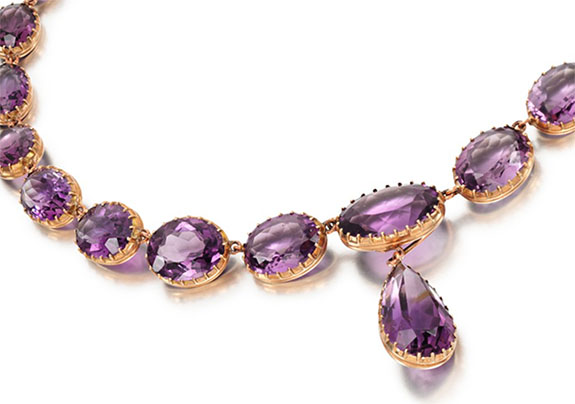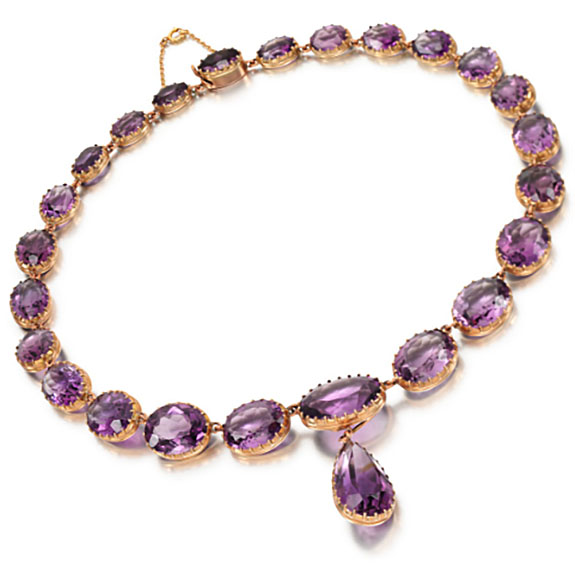February’s Purply Birthstone Has Been Prized for More Than 4,000 Years
To ancient civilizations dating back more than 4,000 years, amethyst was more than just a pretty purply gemstone. It was held in the same high regard as diamond, ruby and emerald, and played an important role in traditions, superstitions and quality of life.
In Greece, wine lovers wore amethyst and used vessels carved from amethyst in an effort to stay sober. In fact, the name “amethyst” is derived from Greek “amethystos” meaning “not drunken.” According to Ancient Greek lore, the stone could ward off the intoxicating powers of Bacchus, the god of wine, and keep the wearer clear-headed and quick-witted.
In Israel, the biblical Aaron (1396 BC – 1273 BC), the first high priest of the Hebrews (and older brother of Moses), wore a gleaming breastplate fashioned with gemstones representing the 12 tribes of Israel. One of the inscribed gems was an amethyst, which symbolized the spirit of God.
In ancient Egypt, skilled artisans carved amethyst into amulets and talismans for religious and magical purposes.
In Rome, philosopher Pliny the Elder (290 BC – 230 BC) believed that an amethyst necklace worn on a cord fashioned from dog's hair would provide protection against snakebites.
During the Renaissance, the brilliant Italian painter and sculptor Leonardo da Vinci (1452 – 1519) was sure to keep the purple gem on his working desk, explaining in a dairy passage that “Amethyst dispels evil thoughts and speeds up thinking.”
The color purple was traditionally the color of royalty, and amethyst was used to adorn the richest and most powerful monarchs and rulers. The English revered the stone for its majestic properties — creating emblems and insignia featuring amethysts during the Middle Ages to symbolize royalty.
In Russia, Catherine the Great (1729–1796) was a big fan of February's birthstone and never missed an opportunity to accessorize her lavish wardrobe with amethyst necklaces, earrings and other ornaments. She was so passionate about the gem that she reportedly sent thousands of miners into the Urals to look for it.
The most prized member of the mineral quartz family, amethyst radiates a wide array of regal purple hues ranging from sparkling lilac to sultry deep violet.
(The gorgeous amethyst necklace, above, was part of Sotheby's Fine Jewels sale in London in June of 2020. Designed in the late 19th century and measuring 410 mm (16 inches) in length, the lot sold for £6,875 (approx. $8,300), which beat the pre-sale high estimate by nearly 15%.)
Historically, the highest-quality amethysts were mined in Russia and set into royal European jewelry. While Brazil is now the primary source of this gemstone, fine-quality amethyst can also be found in parts of Zambia, Mexico, Uruguay, Bolivia, Italy, Germany, Canada and the US. Among the states producing amethyst are Arizona, Maine, Colorado, North Carolina and Pennsylvania.
10 More Facts About Amethyst
- Amethyst has been used to symbolize deep love, happiness, humility, sincerity and wealth.
- Amethyst is the recommended gem for those celebrating their 6th or 17th wedding anniversaries.
- Amethyst is the official gemstone of the province of Ontario and the state of South Carolina.
- Amethyst rings are traditionally worn by Bishops because the gem is said to symbolize spiritual purity.
- Farmers believed wearing amethyst would protect their crops from hailstones and locusts.
- The Hebrew word for amethyst is “ahlamah,” meaning “dream;” the stone was said to cause dreams and visions… and if you dream of amethyst, you will be free from harm.
- When amethyst and citrine combine in the same crystal it is called an ametrine.
- One of the largest amethyst geodes in the world is called Empress of Uruguay. It stands 8 feet tall and weighs 5,000 pounds.
- Cut gems of amethyst are often graded using the terms: Siberian, Uruguayan or Bahian, representing high, medium and low-grade stones regardless of the actual source.
- Amethyst rates a 7 out of 10 on the Mohs scale of hardness.
Credits: Images courtesy of Sotheby's.








